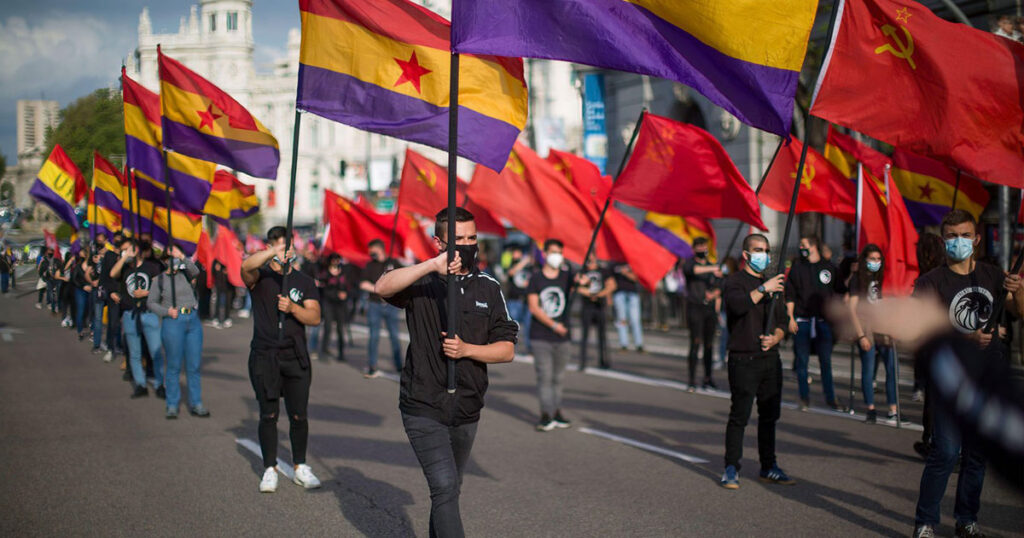
June 14 is flag day in the United States, and Old Glory will be hoisted far and wide across the land. Other flags too will surely flutter. How many newcomers to the States will honor the country of their birth on this day, and how many people will announce old loyalties by hoisting flags from a past they might not have known but nonetheless itch for?
Some national flags are dead simple, like the Japanese red circle on a white banner, and some are complex, like the Turkmenistan flag. The oldest flag of an independent nation is Denmark’s, a white cross on a red field. According to legend, the banner fell from the sky in answer to prayers during the Battle of Lyndanisse against Estonia in 1219, making it more than 800 years old. Even older is Scotland’s flag, a blue field with a white saltire, dating from the eighth century. Perhaps a saltire, used in a number of the Confederate states in the 19th century, will flap on flag day.
The most common color combination for national flags is the red, white, and blue of Old Glory, the Union Jack, and the French Tricolor, as well as of the flag of the Netherlands, which was the model for the French flag. By taking the colors of the Netherlands’s tricolor, France furthered the tradition that three stripes of equal width—whether horizontal like the Netherlands’s or vertical like France’s—signal a change from monarchy to republic.
Vertical, horizontal, red, white, orange, black, blue, yellow, green, stars, stripes, crosses, circles, and coats of arms—the world’s 195 national flags are all glorious. Spain’s flag is red and yellow—or more precisely red and weld, a color from the weld plant—with two narrow red stripes top and bottom and a broad yellow stripe between with the official coat of arms representing six kingdoms of Spain. This design dates back to 1785 and the reign of Carlos III. Some version has been in use ever since. It’s called la rojigualda.
No national flag uses purple, and the reason is the difficulty and expense of obtaining a dye of that color. Because it was so expensive, purple was reserved for the nobility in Roman times. One flag did use purple: the flag of the Second Republic of Spain. On the overthrow of the monarchy in 1931, the new government adopted as its own the same flag that numerous republican groups had been using of three stripes of equal width, red, yellow, and purple. This flag, known as la tricolor, was officially presented to the nation with the new state’s declaration that it came “invested with the double representation of the hope of freedom and of its irreversible triumph.” Eight years later, the republicans lost the Spanish civil war. Those hopes though endured: the tricolor was the official flag of the Spanish Republican government in exile until 1977. It is still used today by the different trade unions and various left-wing political movements, including the modern republican movement.
During the Spanish civil war, the rebels—that is to say, Franco’s band—took up the red and yellow flag again, including the coat of arms. After the war, Franco replaced the coat of arms with a black eagle. That basic insignia endured until after Franco’s death in 1975. Thereafter, the coat of arms was reinstated on the official Spanish flag, which again resembled the flag of Carlos III.
You would think traditionalists would be pleased to see as the official flag one so close to the 250-year-old flag of yore. But conservatives will often raise a flag with no coat of arms, just the unadorned red and yellow bands. This is the civil variation of the national flag. This flag, reduced to the basic elements, seems to suggest an essential heart of Spain, in rejection of politics, including the repudiation of Franco’s flag, which as of 2007 is illegal to display. When Catalonia voted in 2017 to secede from Spain, I saw this simple flag unfurled from homes and apartment balconies in the exclusive neighborhoods of my city, and I imagine it was on display in similar neighborhoods across the country. It’s as if loyalty to the old days, the old ways, was the message, to counter the push for new days and ways. Is anyone ever happy with the current state? Perhaps not. Yet the cyclic nature of even flags shows that some desires do seem eternal. Or at least rise again from the smoking remains after some bloody conflict.
Several flags have been proposed for the planet Earth, the first in 1969, showing sun, Earth, and moon in a beautiful design, and now used by astronomical societies. For the planet, I propose nothing so serene. Instead, a flag depicting a phoenix, rising from the ashes. Yes, from the ashes. Considering what our species burns through and burns up, that might be just the flag. About the burning, some people seem nonchalant, others worried. Some appear eager for it, as if to get on with the next great coming, and to prepare to face any challenger. So far, however, the only enemy is us.

